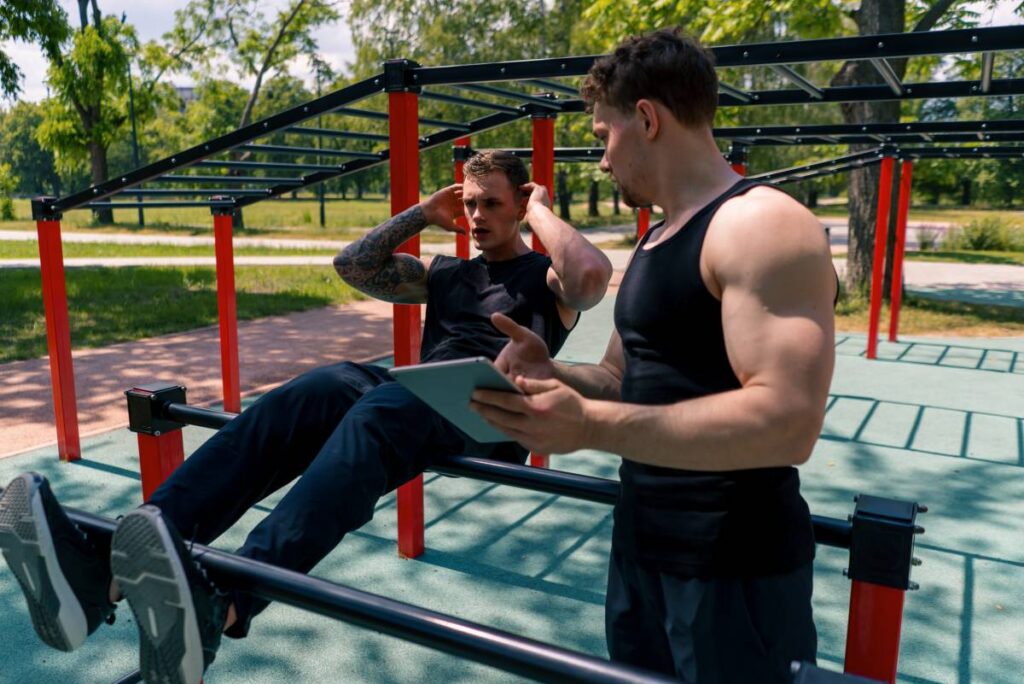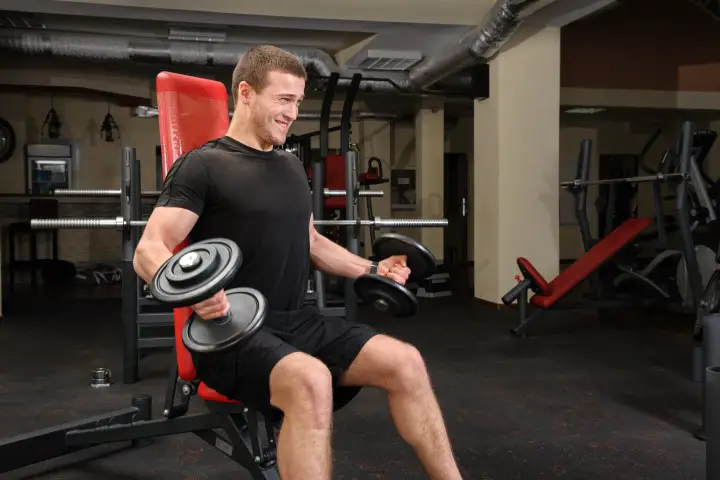Workouts
Best Workout Plan for Skinny Guys: Ultimate Guide

Life is full of challenges, and that’s what makes every transformation worth it. When I started working out two years ago, I faced endless doubts, switched between routines, and expected overnight results. My strength was low, motivation inconsistent, and progress frustrating until I committed to one structured plan: the Push–Pull–Legs (PPL) routine.
This guide isn’t just theory, it’s a mix of real experience and science-backed insights. Here, I’ll share what truly works, the mistakes I made, and how you can follow the best workout plan for skinny guys to finally build muscle effectively.
By the end, you’ll know exactly what to do, what to avoid, and how to train smarter for a sustainable transformation journey. Let’s know together what is the best workout plan for skinny guys.
Why Do Most Skinny Guys Struggle to Stick to a Workout Plan?
Working out with the right mindset is essential before building muscle, you must first build focus. For most skinny guys, sticking to one routine often feels harder than it should. It’s not just about discipline; it’s a mix of psychology, strategy, and physiology working against you. In this part of our best workout plan for skinny guys, we’ll uncover the real reasons behind inconsistency from slow progress and mental burnout to misinformation and how to overcome these traps to finally stay consistent on your transformation journey
1- The Real Struggles of a Skinny Guy

At the start of any transformation journey, motivation runs high and you’re ready to train hard and prove yourself. But soon, frustration kicks in. You follow every tip from social media, jump between routines, and still see little to no visible progress. In today’s world of mixed information, knowing what truly works for skinny guys building muscle becomes the hardest part. Here are the real struggles most face in their early weeks of training:
- Lack of Visible Progress:
During the first few weeks, your body is learning how to lift, not yet building muscle. Without visible results, motivation fades quickly, leading many to quit too soon. - Feeling Weaker in the Gym:
Seeing others lift heavier can crush confidence. But early weakness is normal your nervous system is still adapting before real strength kicks in. - Overtraining and Burnout:
Many skinny guys push too hard, copying influencer-style workouts designed for advanced lifters. The result? Fatigue, poor recovery, and early burnout that kills consistency. - Information Overload:
Jumping between “shortcut” routines and conflicting advice leads to confusion. Without a clear, science-backed structure, even the most motivated beginner loses direction fast.
2- Why Do They Keep Switching from One Plan to Another?

Most skinny guys start strong, motivated, consistent, and excited for change but within a few weeks, they hop to a new routine thinking the last one “didn’t work.” The truth is, your body doesn’t transform that fast. Real results from a structured program like the Best Workout Plan for Skinny Guys take time, adaptation, and patience. Here’s why so many fall into the cycle of switching plans too soon
- Impatience from Slow Visual Results: Muscle growth is a slow biological process. Early gains happen at a microscopic level, improved coordination, stronger neural pathways long before visible muscle appears.
- The 6–10 Week Adaptation Window: Research shows that noticeable muscle hypertrophy typically begins during the 6–10 week phase of consistent resistance training, once your body has completed its early neurological adaptations. Switching plans too early can interrupt this process and prevent real growth from taking hold.
- Social Media Misinformation: “Shortcut” workouts promising instant transformations flood your feed, creating false expectations. In reality, consistency with proper progressive overload beats any trendy 4-week program.
- Lack of Trust in the Process: Without tracking progress or understanding long-term adaptation, skinny guys assume a plan isn’t working. Sticking to one structured routine for at least two months is where transformation actually begins.
3- Understanding Your Body Type and Adaptation

Every skinny guy has a unique physiology, and understanding it is key to building muscle efficiently. Most fall under the ectomorph category naturally lean, with a fast metabolism and slower muscle retention. Knowing how your body responds helps you train smarter, not harder. You can read more about this in our Skinny Guy Bulking Diet guide. Here’s what you need to know about training adaptation and long-term progress:
- Fast Metabolism Isn’t a Curse:
Ectomorphs burn calories faster, which means you must eat more and recover better to gain muscle, not just train harder. - The Plateau Effect:
After months of the same routine, your body adapts and stops responding. Muscles need new challenges, different rep ranges, tempos, or intensity to keep growing. - Progressive Overload for Real Growth:
Gradually increase your weights, reps, or training volume each week. Small, consistent progress is what triggers new muscle tissue to form. - The Power of Deload Weeks:
Taking a light week every 6–8 weeks helps reset fatigue, restore performance, and prevent overtraining allowing your body to come back stronger.
The Foundation: Building a Smart Workout Plan for Skinny Guys
Before you jump into lifting heavy or copying influencer workouts, you need a foundation that actually works with your body not against it. The Best Workout Plan for Skinny Guys starts simple: train smart, focus on quality movements, and build consistency before chasing numbers. This is your starter guide to train effectively while avoiding injuries, fatigue, and burnout.
Step 1: Train Only 4–5 Days per Week

In the beginning, your body and muscles are still adapting to a new level of physical stress. Training too often like 6 or 7 days a week can overload your nervous system and stall growth instead of accelerating it.
During the first 3–4 weeks, aim for 4–5 quality sessions per week. This approach helps your body learn the movements, improve recovery, and develop a mind–muscle connection, the ability to feel and control the muscle you’re working.
Science supports that muscle adaptation improves when rest and recovery are properly balanced with training frequency. As I learned from experience, pushing too hard too soon only caused fatigue and soreness without real progress. Once I reduced training to five focused sessions for at least 2 and a half months, my body finally started adapting and growing.
Recommended Split: Push – Pull – Legs – Rest – Upper – Lower
Start with this routine, stay consistent for at least eight weeks, and allow your body to strengthen at its own pace.
Step 2: Focus on Compound Movements

When starting out, skip the fancy isolation exercises. Focus on compound lifts exercises that engage multiple muscle groups and stimulate real strength development.
Core Compound Movements:
- Bench Press
- Squat
- Deadlift
- Pull-ups
These exercises recruit more muscle fibers, build your foundation faster, and train your coordination. When performed correctly, they not only increase strength but also teach your body how to move efficiently under load.
The key is not to rush your weights instead, master the form and angles. If you start feeling your muscles engage and tighten after 1–2 sets, that’s a sign your training is working. As I experienced firsthand, focusing on form over ego gave me faster strength and confidence gains than any “shortcut routine.”
Step 3: Progress Without Ego Lifting

One of the biggest traps new lifters fall into is ego lifting, adding too much weight too soon just to impress others. This not only kills your long-term progress but also risks injuries that can take months to recover from.
In my early training days, I learned this lesson the hard way. Listening to others push me to lift heavier led to poor form and muscle imbalance. The truth? Lifting 8 kg with perfect control is far superior to swinging 16 kg with bad technique. Even a donkey can lift heavy, but lifting smart is what builds a human body with balance and proportion.
Follow a simple rule: increase your working weight by +2.5 kg each week, but only if your current form and control are solid. Pair this with progressive overload adding small reps or improving your range of motion each session to sustain long-term growth.
The Science Behind Progress and Strength Gain
Building muscle isn’t magic, it’s biology and consistency working together. In the early stages of the Best Workout Plan for Skinny Guys, most of your progress comes not from muscle size, but from something deeper: your brain and nervous system learning how to move efficiently.
Neural Adaptation: Strength Before Size
During the first few weeks, your strength increases even though your muscles look the same. This happens because your nervous system becomes better at recruiting muscle fibers and coordinating movement, a process called neural adaptation. It’s your body’s way of learning the skill of lifting before focusing on growth.
Progressive Overload and Microloading
Once your body masters the basics, real hypertrophy begins. To keep progressing, you must apply progressive overload gradually increasing resistance over time. Even small increases, like adding 1–2.5 kg per week (microloading), send a powerful signal for your muscles to grow stronger and denser.
Tracking for Sustainable Growth
Tracking every workout weights, reps, sets, and rest ensures you’re consistently improving. Without measurable progression, your body has no reason to adapt. Data-driven consistency is the backbone of long-term transformation.
What Study Says?

According to Schoenfeld (2016), muscle growth is primarily driven by training volume and progressive overload meaning consistent increases in tension and workload lead to measurable hypertrophy over time. Which basically opens the room for muscle development over time.
Common Mistakes Skinny Guys Make (Quick Fix)
Even the most motivated beginners can derail their progress with avoidable mistakes. If you want to see real transformation and follow the best workout plan for skinny guys, here’s what you need to stop doing and how to fix it fast.
- Mistake #1 – Doing Too Much Cardio
Burning more calories than you eat keeps you in a deficit.
Fix: Limit cardio to 2× per week, 20 minutes max, focused on light intensity or active recovery. - Mistake #2 – Skipping Meals or Under-Eating
Without a calorie surplus, your muscles can’t grow and they starve.
Fix: Track your calories for 30 days and eat protein-rich meals to support strength and recovery. - Mistake #3 – Changing Workouts Every 2 Weeks
Frequent switching prevents your body from adapting.
Fix: Stick with one structured plan for at least 6–8 weeks to let muscles adjust and grow. - Mistake #4 – Neglecting Form and Recovery
Training with poor technique or little rest leads to injuries and burnout.
Fix: Record your lifts, focus on progressive overload, and get 7–8 hours of sleep daily. - Mistake #5 – Listening to Everyone for Tips
Every other body responds differently; random advice causes confusion.
Fix: Learn to read your body, adjust gradually, and follow one proven routine. - Mistake #6 – Overtraining Upper Body, Skipping Legs
Building only your chest and arms creates imbalance.
Fix: Never skip leg day it boosts hormones, posture, and total-body strength. - Mistake #7 – Training Only When Motivated
Motivation fades, discipline stays. Inconsistency kills results.
Fix: Train even on low-energy days make it a habit, not a hobby. - Mistake #8 – Expecting Overnight Results
Muscle growth is a marathon, not a sprint.
Fix: Be patient; visible change takes 8–12 weeks of proper training and nutrition. - Mistake #9 – Ignoring Sleep and Rest
Growth happens when you rest, not when you lift.
Fix: Prioritize deep sleep and at least one rest day weekly for muscle recovery. - Mistake #10 – Choosing Advanced Workout Plans
Following a pro bodybuilder’s “bro split” overloads beginners.
Fix: Start with beginner-friendly structures like Push–Pull–Legs or Upper–Lower Split before moving up.
Biggest Workout Myths for Skinny Guys
There’s no shortage of gym myths that confuse beginners and keep skinny guys stuck. Let’s clear up the most common ones so you can focus on what actually drives results in the best workout plan for skinny guys.
| Myth | Reality |
| “I need to lift heavy to grow.” | Muscle growth comes from progressive overload gradually increasing volume and intensity, not just lifting the heaviest weight. |
| “Cardio kills gains.” | Moderate cardio (2× per week) actually improves endurance and recovery, helping you train harder. |
| “Supplements replace food.” | Protein powders support your diet but can’t replace real meals that provide complete nutrients and fiber. |
| “More gym time = faster results.” | Overtraining leads to burnout. 4–5 focused sessions with proper recovery deliver better long-term growth. |
| “You can target fat loss in specific areas.” | Spot reduction is a myth fat loss happens overall, driven by diet and consistency. |
| “Training daily builds discipline.” | Discipline means consistency, not exhaustion. Rest days rebuild muscle and prevent injuries. |
| “Abs come from endless crunches.” | Visible abs come from balanced training + calorie control, not just ab exercises. |
| “Stretching before workouts prevents all injuries.” | Dynamic warm-ups and controlled movement prep are more effective than static stretching alone. |
Workout Variations for Every Type of Skinny Guy
Once you’ve built your foundation with consistent 4–5 day training, it’s time to personalize your plan. Not everyone trains under the same lifestyle or energy levels. Students have tight schedules, professionals juggle work stress, and fitness enthusiasts push for progress beyond basics.
Below are practical workout variations that fit your daily routine, recovery ability, and long-term transformation goals.
(If you haven’t completed your first 8–10 weeks yet, start with the beginner plan in our Skinny to Muscular Transformation Guide before moving to these structured workouts.)
Student Routine (Minimal Equipment)

When gym access is limited, the goal is to build control, mobility, and basic strength through bodyweight exercises.
- Key Exercises: Push-ups, dips, squats, planks, pull-ups
- Frequency: 4–5 sessions per week, 40–60 minutes each
- Quick Tip: Perform slow, controlled reps and increase difficulty over time (add backpack weight or tempo holds).
- Goal: Build coordination and strength endurance before moving to weights.
Busy Professionals Routine (4-Day Split)
If your work schedule leaves little time for the gym, this 4-day plan keeps intensity high without overtraining:
- Day 1: Push (Chest, Shoulders, Triceps)
- Day 2: Pull (Back, Biceps)
- Day 3: Legs + Core
- Day 4: Full-Body Strength / Mobility Work
Each session lasts around 60 minutes with supersets and short rest periods.Goal is to Stay consistent, maintain balance, and train efficiently even on busy days.
Fitness Enthusiast Routine (6-Day Split)
After 2–3 months of consistent training, your body can handle more volume and intensity. This version of the best workout plan for skinny guys takes your routine to the next level.
- Day 1: Push
- Day 2: Pull
- Day 3: Legs
- Day 4: Rest / Light Cardio
- Day 5: Upper
- Day 6: Lower
- Day 7: Rest
Add deload weeks every 8–10 weeks to reset fatigue and prevent burnout. The goal is to build strength and definition through progressive overload and strategic rest.
Ahmad’s Routine (6–8 Month Progression)

Once your base strength is built, variation becomes essential to keep growing. This is my personal split ideal for intermediate lifters.
- Main Split: Push–Pull–Legs (rotated every 2–3 months to Push–Leg–Pull)
- Training Days: 6 per week + 1 rest day
- Abs Training: 3–4 times/week on alternate days
- Focus: Maintain form, apply gradual overload, and tweak tempo or volume every few months.
Changing the order or angles keeps the body responsive and prevents plateaus; it’s what keeps training fun and effective long-term. The goal is to challenge your body smartly while staying consistent and injury-free.
The best workout plan for skinny guys isn’t the most complex, it’s the one you can sustain.Focus on steady progression, enough recovery, and learning your body’s rhythm. That’s how you grow for life.
Training for Balance and Weak Body Parts
Building muscle isn’t just about getting bigger it’s about building symmetry, balance, and total-body control. Many skinny guys reach a point where some muscles grow faster than others, one arm looks fuller, or the chest feels uneven. Understanding how to spot and fix these lagging muscles turns a good physique into a well-balanced one.
1- Identify Your Weak Points
Before you correct imbalances, awareness is your tool:
- Use Mirrors or Video Feedback
Record lifts bench, curls, rows to observe uneven motion or one side compensating. - Track Performance
If one arm fails earlier, lifts lighter, or fatigues faster, that’s your weaker side. - Mind–Muscle Check
During sets, consciously feel both sides contract. Internal focus (mind–muscle connection) helps recruit more motor units.
Research Insight:
Asymmetric strength often originates from neuromuscular imbalances, not just size differences. Focusing on weaker limbs with unilateral training reduces asymmetry over time (via increased activation on the lagging side).
2- Weekly Fix Strategy

Once you identify weak areas, slightly prioritize them in your weekly routine:
- Train the weaker muscle first when your energy is highest.
- Add 1–2 extra sets or reps for that side to stimulate equal growth.
- Include unilateral exercises (e.g., one-arm dumbbell presses, single-leg squats, one-arm rows).
I trained my weakest muscle first each session and it grew fastest. When I noticed my left arm was weaker, I added two assisted reps using my right arm for about two months. Eventually, both arms matched in power and control.
3- Progressive Symmetry Method
To ensure long-term balance and proportion, follow this simple cycle:
- Track Each Side’s Performance weekly for weight, reps, and control.
- Apply Progressive Overload only after both sides perform evenly.
- Every 3–4 weeks, include a light “balance session” using lower weights and slower tempo to refine control and coordination.
Supporting Study:
A review published in the Journal of Strength and Conditioning Research (2018) found that unilateral and tempo-controlled training improves symmetry, coordination, and muscular aesthetics essential for building a balanced, athletic body.
Balanced Body Framework (Quick Reference)
| Problem | Fix | Result |
| One side weaker | Train it first, add 1–2 extra reps | Equal strength in 4–6 weeks |
| Uneven chest/shoulders | Use dumbbells instead of barbells | Balanced upper-body symmetry |
| Lagging legs or glutes | Add lower-body accessories (lunges, hip thrusts) | Better proportion & stability |
| Poor mind–muscle link | Focus on tempo + internal cueing | Stronger connection & control |
The goal is not to just build size, it’s about building balance. True transformation is when every muscle supports the next in both strength and symmetry.
Psychology of Consistency: Building Mental Power

Physical gains are only part of the transformation mental strength keeps you going when results plateau. Many skinny guys struggle not from lack of workout knowledge, but from overthinking, gym anxiety, and comparing themselves to others. To build lasting consistency, small psychological tools matter: tracking tiny improvements, journaling emotions and barriers, and reinforcing belief in your own capacity. Studies show that higher self-efficacy and intrinsic motivation are strong predictors of sticking with an exercise routine.
In my own journey, I trained alone for months with no partner, no hype yet every rep added to my mental resilience. On days doubt crept in, I reminded myself: discipline outlasts motivation. The best workout plan for skinny guys isn’t just about form or volume, it’s about building the mindset that shows up, even when the mirror doesn’t reflect progress.
3-Month Sample Workout Plan for Skinny Guys
This 3-month plan is designed to guide students, busy professionals, and fitness enthusiasts through the essential stages of building strength and muscle. Each month has a focused goal, simple structure, and clear progression that adapts to your lifestyle. Whether you train at home or in the gym, this plan builds real consistency and visible results.
| Month | Focus | Key Exercises | Goal |
| Month:1 Foundation | Build stability and technique with lighter intensity. Train 4–5 days/week. | Push-ups, Pull-ups (or Resistance Bands), Bodyweight Squats, Planks, Dips | Develop proper form, endurance, and mind–muscle control. |
| Month:2 Strength Phase | Transition to structured weight training. Train 5 days/week with rest after leg day. | Bench Press, Barbell Rows, Deadlifts, Overhead Press, Lunges | Build overall strength and power through progressive overload. |
| Month:3 Growth & Definition | Focus on hypertrophy (8–12 rep range) and balanced volume. Train 5–6 days/week with deload if needed. | Incline Dumbbell Press, Cable Rows, Romanian Deadlift, Pull-Ups, Shoulder Raises, Leg Press | Achieve visible muscle size and balanced physique with controlled intensity. |
Pair this plan with a nutrient-rich, calorie-surplus diet to maximize results. Muscles don’t grow without fuel recovery and nutrition are half the transformation. Check out our full guide: Best Diet for Skinny Guys
Link Your Diet and Training for Maximum Growth
“If you don’t eat right, you’re only doing half the job.”
Your training builds the foundation, but nutrition decides how strong that foundation becomes. Many skinny guys train hard yet stay the same because their body doesn’t get enough fuel to repair and grow. The perfect transformation happens when your workout routine and diet work together; one creates stress, the other drives the recovery.
To get the most from your workouts, follow a structured calorie-surplus meal plan aligned with your training phase. You can learn the exact approach from portion balance to meal timing in our skinny to muscular transformation nutrition guide and the detailed bulking diet plan for beginners. These explain how to match your calorie intake with your workout intensity for steady, visible results.
Remember one thing, training builds the body you see eating right builds the body you keep.
Conclusion

Every skinny guy begins with the same question: “Can I really change?”
The truth is, yes but only if you commit to consistency, patience, and purpose. Muscle doesn’t grow from perfect plans alone; it grows from the moments you show up when no one’s watching. Whether you’re a student training between classes, a professional balancing work stress, or an enthusiast pushing through fatigue, your progress is the reflection of daily discipline.
Stay loyal to the basics, train smart, eat enough, sleep well, and track your growth. Transformation isn’t about chasing quick results; it’s about becoming someone who doesn’t quit. Remember, the best workout plan for skinny guys isn’t built in the gym or the kitchen, it’s built in the mind that refuses to give up. Your journey from skinny to strong starts with a single decision to stay consistent long enough to see what you’re capable of.
FAQs: Best Workout Plan for Skinny Guys
1. How many days per week should a skinny guy train?
4–5 days per week is ideal for beginners. This frequency allows your body to recover and adapt while building a strong mind–muscle connection before moving to higher-volume training.
2. When will I start seeing muscle growth results?
Visible results usually appear after 6–10 weeks of consistent training and eating in a calorie surplus. Strength often improves first due to neural adaptation before muscle size increases.
3. What’s the best workout split for skinny guys?
Start with a Push–Pull–Legs or Upper–Lower split. These structures balance workload, recovery, and progressive overload for steady growth.
4. Can I build muscle with bodyweight exercises only?
Yes, beginners can start with push-ups, squats, dips, and planks to build strength and stability. Once your body adapts, add resistance or weights to continue progressing.
5. Should skinny guys avoid cardio?
Not entirely. Limit cardio to 2 sessions per week, about 20 minutes each, focusing on light intensity or active recovery. Too much cardio can burn the calories you need for muscle gain.
6. What’s more important: diet or training?
Both matter equally. Training stimulates muscle growth, but nutrition fuels it. Without enough calories and protein, your body can’t repair and build new muscle tissue.
7. How can I fix muscle imbalance or weak body parts?
Train your weaker side first, add a few extra reps, and focus on unilateral exercises like single-arm rows or dumbbell presses. Mind–muscle awareness and controlled tempo improve symmetry.
8. How can I stay consistent when motivation fades?
Focus on discipline, not motivation. Track small wins, journal your workouts, and remember why you started. Progress is built on habits, not mood.
9. Do supplements replace food for skinny guys?
No, supplements only support your diet. Real progress comes from whole foods rich in protein, complex carbs, and healthy fats.
10. What’s the biggest mistake skinny guys make in the gym?
Jumping between routines too fast. Stick to one structured plan for 8–12 weeks before making changes. Consistency beats variety when you’re building a foundation.

Ahmad Hassan is a fitness writer and transformation coach behind GymWithMind.com, specializing in the Skinny to Muscular Transformation niche. After going from 51 kg to 65 kg naturally, he now shares science-backed, practical strategies to help skinny guys build lean muscle through smart training, balanced nutrition, and consistency. His guides blend real experience with research to make fitness simple, achievable, and sustainable


 Skinny to Muscular1 year ago
Skinny to Muscular1 year agoDiscover Elite Body Sculpting: Best 8 Method Revealed For Precision Shaping:

 Skinny to Muscular1 year ago
Skinny to Muscular1 year agoRealistic 6 Month Body Transformation Female: From Struggle To Power

 Skinny to Muscular1 year ago
Skinny to Muscular1 year agoBody Fitness Tips For Female; Unleashing Fitness Secrets

 Skinny to Muscular2 years ago
Skinny to Muscular2 years agoHow To Lose 50 Pounds in 5 Months: Is it possible ?

 Skinny to Muscular1 year ago
Skinny to Muscular1 year ago9 Best Front Squat Alternative At Home And Gym:

 Skinny to Muscular1 year ago
Skinny to Muscular1 year agoTop 12 Books For Strength Coaches:

 Skinny to Muscular2 years ago
Skinny to Muscular2 years agoKettlebell Golf Workout;- Get Ready For Swing

 Skinny to Muscular1 year ago
Skinny to Muscular1 year ago15 Best Strength And Conditioning Books